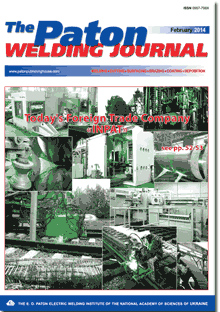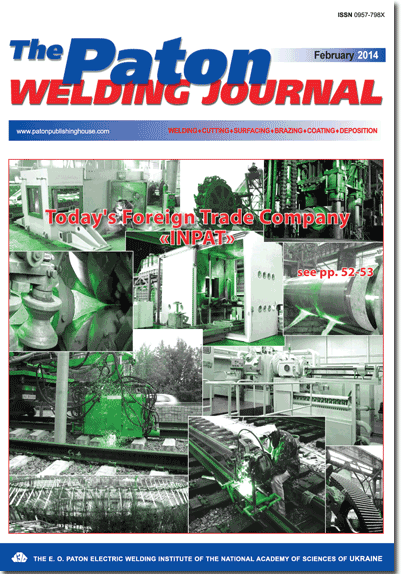| 2014 №02 (05) |
DOI of Article 10.15407/tpwj2014.02.06 |
2014 №02 (07) |

The Paton Welding Journal, 2014, #2, 42-46 pages
STRUCTURE AND PROPERTIES OF WELDED JOINTS OF 15Kh1M1FL STEEL AT REPAIR OF CASTING DEFECTS BY TRANSVERSE HILL METHOD
N.G. EFIMENKO1, O.Yu. ATOZHENKO1, A.V. VAVILOV2, A.G. KANTOR2 and E.I. UDALOVA2
1NTU «Kharkov Polytechnic Institute». 21 Frunze Str., 61002, Kharkov, Ukraine. E-mail: svarka126@ukr.net
2OJSC «Turboatom». 199 Moskovsky Ave., 61037, Kharkov, Ukraine
Abstract
Welding up casting defects in power equipment components from thermally stable steels involves the risk of brittle fracture as a result of increased volumetric stress state. Studying the influence of technological measures for controlling the thermodeformational welding cycle in order to obtain a favourable structure and properties in welded joints, is of interest. In this work the influence of transverse «hill» welding without preheating or heat treatment on mechanical properties and structure of various zones of welded joints from 15Kh1M1FL steel was studied, and these values were compared with the properties of welded joints after welding with preheating by the standard technology. It is established that after transverse «hill» welding upper granular bainite structure forms in the high-temperature zone of HAZ metal and in the weld metal, which is characterized by an optimum set of mechanical properties, namely a combination of high strength with high enough impact toughness values. It is shown that cold cracking resistance after transverse «hill» welding without preheating is higher than after welding by the standard technology. 12Ref., 6 Figures.
Keywords: steel, welding, preheating, heat treatment, granular bainite, subgranular structure, properties
Received: 30.09.13
Published: 28.02.14
References
1. Kozlov, R.A. (1986) Welding of heat-resistant steels. Leningrad: Mashinostroenie.
2. Panov, V.I. (1993) Preheating of welded structures of heavy machine-building. Tyazh. Promyshlennost, 4, 14-17.
3. Panov, V.I. (2007) Universal procedure of repair welding of large-sized massive structures of heavy machine-building. Svarochn. Proizvodstvo, 4, 11-17.
4. Sinadsky, S.E., Panov, V.I. (1985) Autoheating and autoheat treatment in transverse hill welding. Ibid., 11, 3-5.
5. Efimenko, N.G., Orlov, M.V., Levenberg, N.E. et al. Method of multipass welding. USSR author's cert. 1816595. Int. Cl. A1B23K9/16. Publ. 23.05.93.
6. Levenberg, N.E., German, S.I., Fomina, O.P. et al. (1973) About structure of heat-affected zone of welded joints of steels 15Kh1M1FL, 25Kh2NMFA and 20Kh2MFA. Avtomatich. Svarka, 6, 19-21.
7. Cheprasov, D.P. (2006) Structure and phase composition of granular bainite in the region of complete recrystallization of HAZ on low-carbon low-alloy steels. Svarochn. Proizvodstvo, 2, 3-8.
8. Kasatkin, B.S., Kozlovets, O.N. (1992) Macrostructural martensitic-austenitic component in welded joints of high-strength low-alloy steels (Review). Avtomatich. Svarka, 9/10, 3-12.
9. Tsaryuk, A.K. (1979) Peculiarities of development of plastic deformation in processes of welded joint formation: Syn. of Thesis for Cand. of Techn. Sci. Degree. Kiev: PWI.
10. Lobanov, L.M., Mikhoduj, O.L., Poznyakov, V.D. et al. (2003) Method of evaluation of effect of residual stresses on formation of longitudinal cold cracks in alloy steel welded joints. The Paton Welding J., 6, 6-10.
11. Bernshtejn, M.L. (1977) Structure of deformed metals. Moscow: Metallurgiya.
12. Dyachenko, S.S. (2007) Physical principles of strength and plasticity of metals: Manual. Kharkiv: KhNADU.
Suggested Citation
N.G. EFIMENKO, O.Yu. ATOZHENKO, A.V. VAVILOV, A.G. KANTOR and E.I. UDALOVA (2014) STRUCTURE AND PROPERTIES OF WELDED JOINTS OF 15Kh1M1FL STEEL AT REPAIR OF CASTING DEFECTS BY TRANSVERSE HILL METHOD. The Paton Welding J., 02, 42-46.The cost of subscription/purchase order journals or individual articles
| Journal/Currency | Annual Set | 1 issue printed |
1 issue |
one article |
| TPWJ/USD | 384 $ | 32 $ | 26 $ | 13 $ |
| TPWJ/EUR | 348 € | 29 € | 24 € | 12 € |
| TPWJ/UAH | 7200 UAH | 600 UAH | 600 UAH | 280 UAH |
| AS/UAH | 1800 UAH | 300 UAH | 300 UAH | 150 UAH |
| AS/USD | 192 $ | 32 $ | 26 $ | 13 $ |
| AS/EUR | 180 € | 30 € | 25 € | 12 € |
| SEM/UAH | 1200 UAH | 300 UAH | 300 UAH | 150 UAH |
| SEM/USD | 128 $ | 32 $ | 26 $ | 13 $ |
| SEM/EUR | 120 € | 30 € | 25 € | 12 € |
| TDNK/UAH | 1200 UAH | 300 UAH | 300 UAH | 150 UAH |
| TDNK/USD | 128 $ | 32 $ | 26 $ | 13 $ |
| TDNK/EUR | 120 € | 30 € | 25 € | 15 € |
AS = «Automatic Welding» - 6 issues per year;
TPWJ = «PATON WELDING JOURNAL» - 12 issues per year;
SEM = «Electrometallurgy Today» - 4 issues per year;
TDNK = «Technical Diagnostics and Non-Destructive Testing» - 4 issues per year.


